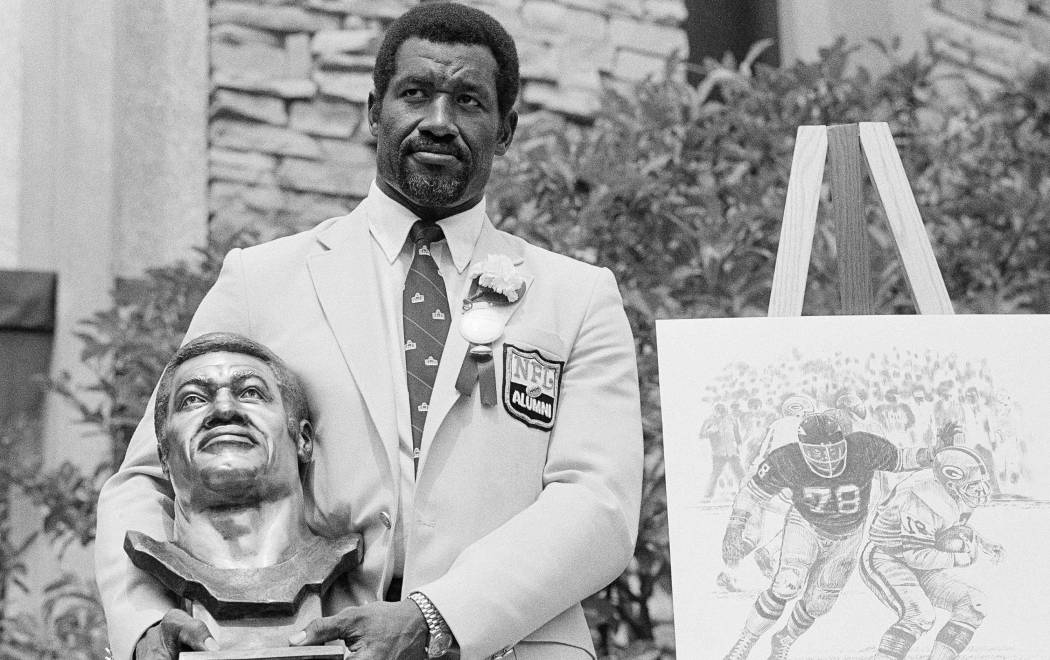Gold Jacket Spotlight: Bobby Bell Could Play Any Position

What do you do with a player whose talent is so abundant he could be placed at any position on the football field and excel?
That was the question each coach of Bobby Bell’s needed to answer as he progressed from an all-state high school standout in Shelby, N.C., to a two-time All-American at the University of Minnesota to a Pro Football Hall of Famer following a 12-year professional career with the Kansas City Chiefs.
The football accomplishments of a player whom some consider the greatest all-around athlete to put on a pair of shoulder pads is revisited this week in the Gold Jacket Spotlight.
Hall of Fame head coach Hank Stram gushed at length about Bobby, especially while presenting him for enshrinement in 1983.
“He was the only player in my 30 years of coaching that had the ability to play any position on a football team and that team would still win,” Stram said. “He was blessed with outstanding skill and ability, and I think he was probably the most versatile player I have ever been associated with – or anyone has ever been associated with. And without a doubt, the greatest outside linebacker that ever played the game.”
Bobby was the first outside linebacker elected to the Pro Football Hall of Fame and the first member of the Chiefs teams that appeared in two of the first four Super Bowls to be enshrined. They won Super Bowl IV, defeating the Vikings 23-7, to cap a 1969 season that saw Bobby named first-team All-Pro for the fifth of his six times and be selected to the AFL All-Star Game (and later Pro Bowl) for the sixth time in a stretch of nine consecutive seasons.
Among his personal highlights that season were a career-best three fumble recoveries and an unusual touchdown scored against the Broncos. Clinging to a seven-point lead after a Denver touchdown, Stram made sure his best athlete was on the field as the Broncos kicked off. Bobby scooped up the onside attempt and returned it 53 yards to seal a 31-17 victory.
Bobby was an all-state halfback when his high school team played six-man football, then all-state at quarterback the following season when it played 11-man football. His college coach, looking to get as many of his best athletes on the field at the same time, converted Bobby to offensive tackle and defensive end. He even played some center, a skill he carried into the pros as the Chiefs’ long-snapper.
Several Chiefs teammates said he could throw a football 80 yards. He ran the 40-yard dash in the 4.5-second range.
He slipped to the seventh round of the 1963 AFL Draft, however, because everyone assumed he was a lock to play for the Vikings, who had drafted him in the second round (16th overall) in the NFL Draft.
Bobby signed with the Chiefs in the relatively young AFL.
“We brought him in as a defensive end because we felt we needed help drastically at that spot. He played there for a year and did it very well,” Stram said in his presentation speech. “And then we moved him to linebacker, and at that particular time we deliberated really about the fact that he might play a strong safety, a weak safety or even a cornerback. Then he played linebacker.”
Bobby thrived at left outside linebacker in Stram’s “stack defense.” He played in all 168 games of his pro career and finished with 26 interceptions – six that he returned for touchdowns. The Chiefs credited Bobby with 40 career sacks (the statistic was unofficial at the time), and Stram called him the best open-field tackler he ever saw.
“He was really something very special, and we are all very, very proud in the fact that he did so well,” Stram said in Canton, where this week Bobby’s career returns to center stage in the Gold Jacket Spotlight.
Stories From The Hall of Fame Archives: Field General Reputation Fit Hanburger's Military Upbringing
There are many values shared between the military and the game of football.
Hall of Fame to Host United States Marine Corps Silent Drill Platoon on June 2
Performance part of 'Military Appreciation Day' at the Hall which includes free admission for all military personnel.